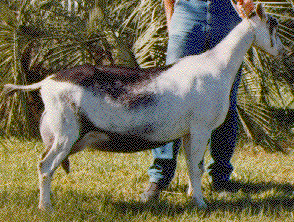| Items in ( ) indicate correct pronunciation |
Cou Blanc
(coo blanc) |
Literally “white neck” – white front quarters and black hindquarters with black or gray markings on the head. |
Cou Clair
(coo clair) |
Literally “clear neck” – front quarters are tan, saffron, off-white, or shading to gray with black hindquarters. |
Cou Noir
(coo nwah) |
Literally “black neck” – black front quarters and white hindquarters. |
Sundgau
(sundgow) |
Black with white markings such as underbody, facial stripes, etc. |
| Pied |
Spotted or mottled. |
Chamoisee
(shamwahzay) |
Brown or bay – characteristic markings are black face, dorsal stripe, feet and legs, ans sometimes a martingale running over the withers and down to the chest. Spelling for a male is chamoise. |
| Two-tone Chamoisee |
Light front quarters with brown or gray hindquarters. This is not a Cou Blanc or Coo Clair as these terms are reserved for animals with black hindquarters. |
| Broken Chamoisee |
A solid chamoisee broken with another color by being banded or splashed, etc. |
| Any variation in the above patterns broken with white should be described as a broken pattern such as broken cou blanc. |
Breed Description
|
| The sleek, short-haired, multicolored French Alpine tends to look larger, “rangier,” and fine boned with more space between the ground and the underline than other large dairy goats. Although the angularity and width should still be present, they may not be as obvious. The head may be as wide between the very alert eyes, but because it it longer, the width may not be as apparent. The “dish” in the bridge of the nose will be less severe, sometimes being almost straight. The muzzle may not appear to be as wide as deep, and the ears may be longer, although just as alert. Origin: France. |
| Alpine Does |
| Conformation and General Appearance: |
Large, rangy, fine-boned, angular, alert, graceful. |
| Height: |
30″ or more at withers |
| Weight: |
135 pounds or more |
| Head: |
Long, lean, clean-cut, dished angular, broad forehead; strong, tapered muzzle |
| Ears: |
Alert, erect, narrow, fine |
| Neck: |
Long, slender, feminine, no dewlap |
| Body: |
Long, angular, well-sprung ribs; deep and wide barrel; straight back, broad, long rump only slightly sloping; full and deep chest |
| Legs & Feet: |
Neat, clean, refined, long, slender, strong. Small, clean, true hooves (not splayed or turned inward or outward). Upright, strong, medium-length pasterns. Wide in hocks |
| Coat: |
Preferably short hair, close, glossy. Thin, pliable skin |
| Colors: |
Any color or combination. See above for variations. |
| Udder: |
Capacious, well-attached, even, pliable, soft, with well-formed, conical, well-deliniated teats. |
| Alpine Bucks |
| Conformation and General Appearance: |
Large, rangy, masculine but refined, vigorous |
| Height: |
32″ or more at withers |
| Weight: |
170 pounds or more |
| Head: |
Long, lean, angular, broad forehead; strong, tapered, firm muzzle; medium beard |
| Ears: |
Alert, erect, narrow, fine |
| Neck: |
Long, well-muscled and powerful, no dewlap |
| Body: |
Long, deep, well-sprung ribs; straight back; broad, long rump only slightly sloping; deep, broad chest |
| Legs & Feet: |
Long, straight, strong. Small, clean, true hooves (not splayed or turned inward or outward). Pasterns strong; Wide in hocks |
| Coat: |
Preferably short hair, close, glossy. Thin, pliable skin; longer spinal hair |
| Colors: |
Any color or combination. See above for variations. |
| Reproductive Organs: |
Well-developed, well-supported; two teats well-balanced and evenly spaced. |
|



Comments